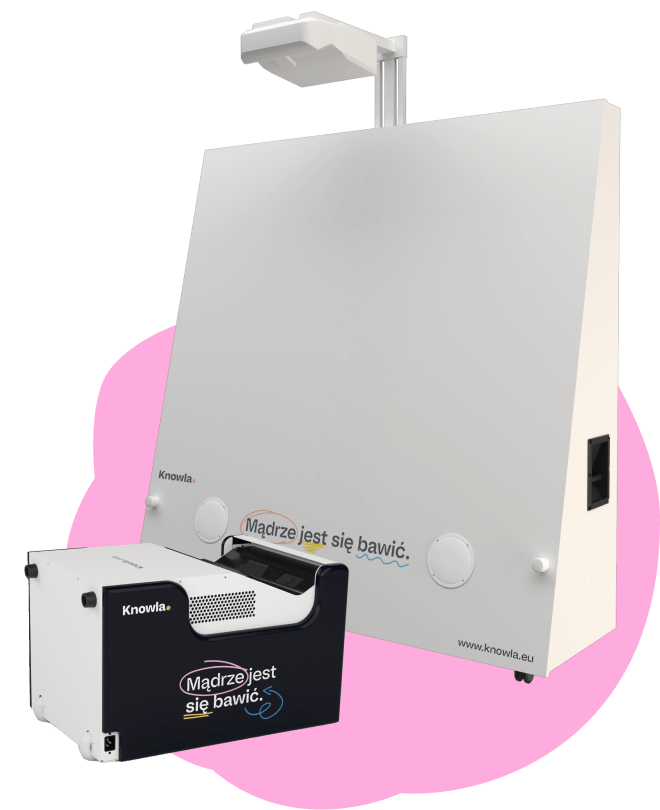Klasy: wczesnoszkolne 1-3
Temat: Wytrwałość i dokładność dogania szybkość.
Cel ogólny:
Uczeń zna zalety pomiędzy szybkim a wytrwałym dążeniem do celu.
Cele operacyjne:
Uczeń rozpoznaje różnicę pomiędzy szybkim a dokładnym dążeniem do celu i zna ich wady i zalety.
Uczeń poznaje zasady działania różnych ćwiczeń fizycznych.
Uczeń poznaje swoje aktualne możliwości i zdolności fizyczne.
Uczeń zdaje sobie sprawę, że inni posiadają inne możliwości i zdolności oraz że nie jest to nic złego.
Punkty podstawy programowej:
Cele kształcenia – wymagania ogólne: I.1-5. IV.1-3,6,8,12.
Treści nauczania – wymagania szczegółowe: I.1. I.2.1-3. I.3. II.6.9. VII.1,4. IX.1. XI.2.2.
Czas pracy: 2 godziny lekcyjne
Metody i formy pracy: ćwiczenia fizyczne, dyskusja, praca w grupach, czytanie, zabawa
Edukacyjny Wszechświat Knowla:
- Joga — Planeta Ziuuu
- Ćwiczenia fit — Planeta Ziuuu
- Trenuj refleks — Planeta Fruu
Przebieg zajęć:
W ramach zajęć w-f:
- Przeprowadzamy rozciągające ćwiczenia rozgrzewkowe.
- Możemy wykorzystać w ramach nich pakiety aktywności Joga z Planety Ziuuu.
- Włączamy aktywność Ćwiczenia fit (Planeta Ziuuu).
- Instruujemy dzieci, że mają wykonywać ćwiczenia pokazywane przez Stworka: jak najwięcej powtórzeń w podanym czasie.
- Po zakończeniu dajemy chwilę na złapanie oddechy oraz pytamy, jak się czuły, czego doznawały w czasie ćwiczeń, oraz po nich.
- Ponownie włączamy tę samą aktywność, ale tym razem instruujemy dzieci, żeby wykonywały ćwiczenia powoli oraz dokładnie tak, jak przedstawia je stworek.
- Po zakończeniu ponownie pytamy o odczucia i doznania, np. jakie mięśnie napinały im się podczas ćwiczenia (można również pytać o to w czasie wykonywania powtórzeń). Pytamy się również, czy zauważyły jakąkolwiek różnicę pomiędzy pierwszą a drugą serią. Warto zaznaczyć, że doznania mogą się nieznacznie różnić między osobami.
- Urządzamy wyścigi.
- Do przeprowadzania są dwa wyścigi: na krótkim (np. jedno okrążenie) i długim dystansie (np. 6 okrążeń). Ich wielkość należy dostosować do warunków, jakimi dysponujemy oraz znanym nam zdolnościom fizycznym uczniów. Dobrze by było, gdyby drugi bieg był na tyle długi, żeby nie potrafili utrzymać sprintu przez cały czas, co przyda nam się w drugiej części.
- Po zakończeniu obu dopytujemy, który wyścig im bardziej pasuje oraz jaką strategię na jego ukończenie przyjęli a w tym, jak się sprawdziła.
- Przeprowadzamy końcowe ćwiczenia rozciągające.
W ramach zajęć w sali lekcyjnej:
- Dyskusja:
- Przypominamy różne strategie na zwycięstwo w wyścigach, które odbyły się na w-f. Np.: szybki początek i co było dalej, kiedy zabrakło im sił i zwolnili, powolny ze stabilną prędkością bieg.
- Otwieramy na urządzeniu pdf z wykresem w wersji do edycji
- Każdy uczeń swoim kolorem zaznacza, jak biegł w czasie całego długiego wyścigu przy każdym kolejnym okrążeniu.
- Można się zastanowić, czy moje szybko = twoje szybko oraz porozmawiać o różnicach w zdolnościach uczniów. Jeśli ktoś nie biega szybko, można wskazać na wytrwałość czy inne zdolności, jakie posiada uczeń.
- Czytamy Bajkę o zającu i żółwiu.
- W zależności o klasy czyta nauczyciel, wybrany uczeń, uczniowie po kolei lub czytają samodzielnie po cichu.
- Obok strategii na wyścigi uczniów zapisujemy strategię na wyścig żółwia i zająca.
- Szukamy zająców oraz żółwi w naszej klasie. Na podstawie wykonanego wykresu lub przez podniesienie ręki.
- Ktoś nie może się dopasować? Dlaczego? Można mu pomóc się przypisać lub wspólnie wymyślić zwierzę, które mogłoby tak właśnie pokonywać wyścig.
- Dzielimy klasę na żółwi oraz zająców.
- Każda grupa musi przygotować cechy przykładnego żółwia czy zająca oraz wady i zalety takiego dążenia do celów. Nie tylko w kontekście wyścigów, ale również, jeśli chodzi o osiąganie innych rzeczy, np.: jak odrabialiby dużą pracę domową, w jaki sposób by się uczyli do sprawdzianu, jak sprzątaliby pokój, jak szykują się rano do szkoły itd.
- Jeśli w klasie pojawiły się inne zwierzaki, mogą utworzyć oddzielną grupę lub dołączyć do jednej z dwóch grup.
- Obie grupy się wypowiadają — dyskusja.
- Jak dzieci się zachowują w różnych sytuacjach.
- Zabawa na koniec — Trainer (Planeta Fruu)
- Dzieci sprawdzają między sobą swoją szybkość i dokładność.

